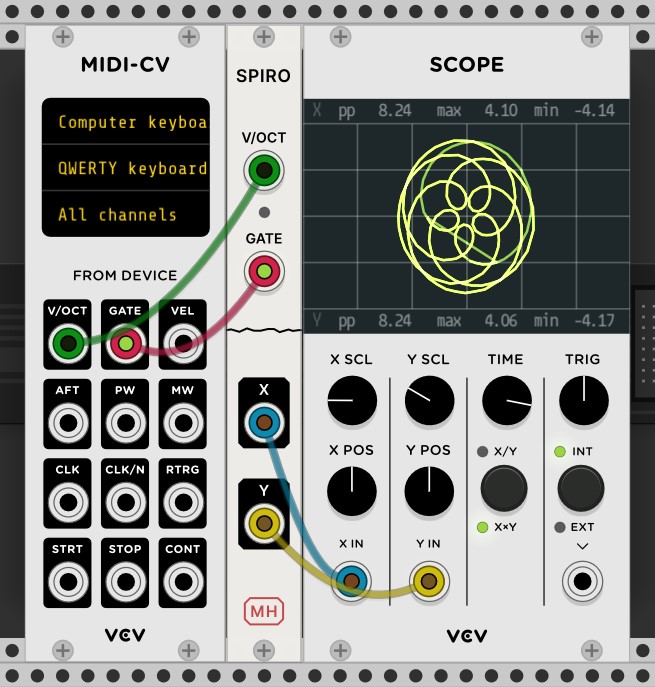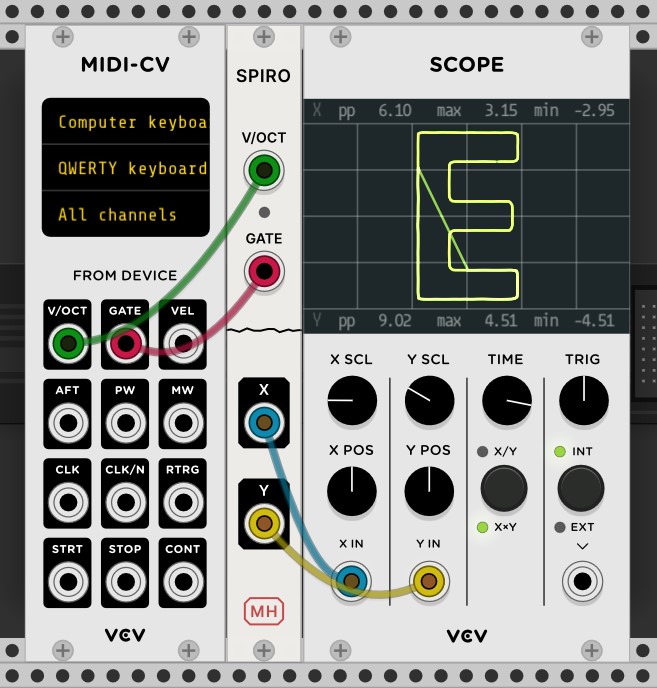Solution to Voltage-Controlled
The puzzle contains 11 screenshots of software modular synthesizer patches, a number of “snippets” of letters and numbers in sorted order, and a few blanks at the bottom.
We can determine the screenshots are all of VCV Rack, a free and open source Eurorack modular synthesizer simulator, by googling the names of a few of the modules.
The first step is to reproduce all of the synth patches by downloading VCV Rack ourselves, finding the same modules, connecting them with patch cables, and setting the knobs in the same way as seen in the images. Some modules used in the patches were created by third-party developers, so we must find those in the VCV Rack Library and add them to our account. All of the patches use the MIDI-CV module set to “QWERTY keyboard”, which lets us play the synthesizer by tapping keys on a computer QWERTY keyboard.
The mapping of QWERTY keyboard key to musical pitch can be seen in the following image, found in the VCV Rack manual:

We infer that the letters, numbers, and punctuation (square brackets) that appear on the snippets at the bottom of the puzzle are notes meant to be played as keyboard input through one of the synth patches. The ripped edges on the snippets suggest we should first piece them together like a jigsaw to produce recognizable musical melodies. Eleven of the snippets have beveled, rather than ripped, left edges (which matches the number of Rack patch screenshots), so we can guess that these are the “starting points”. Eleven other snippets have red outlines, so we might also guess at this point that one of these will appear in each line and be used somehow for extraction.
The snippets are short enough that piecing together the melodies from the given letters/musical notes alone is quite difficult. Fortunately, we can use the VCV Rack patches to help, since each one of them reproduces an iconic synthesizer sound from a well-known song — if we can recognize the timbre, or use it as a clue to jog our memory, it’s easier to piece together that tune out of the snippets.
After reassembling all the melodies, matching them with the corresponding synth patches, then playing the notes on our computer, we can identify the following 11 songs:
| Song | Artist | Snippets | VCV patch audio | Original audio (for comparison) |
|---|---|---|---|---|
| Just Dance | Lady Gaga | E63 Y6E 63 Y6 | ||
| Scary Monsters and Nice Sprites | Skrillex | BTRT 7TO I7VJ NR3W QJR JBJW ]O7 T[7 TRBT RT7 TOI7 VJN R3W | ||
| Axel F | Harold Faltermeyer | R6RR 7R3 RIR R9I 6RI [R3 3QTR | ||
| Take On Me | a-ha | 55W MME EE6 6YU YYY EW55 5E E5E | ||
| The Final Countdown | Europe | 2M2 GW2 W2M W2W GMNM NHMN | ||
| Popcorn | Hot Butter | UYU5 W5MU YU5W 5MU 9O9O U9U9 YUY UTU | ||
| Megalovania | Toby Fox | WWOY 6TR WRT QQO Y6T RWRT | ||
| Nuthin’ But a “G” Thang | Dr. Dre | UYU9 UYT5 E5UY U9UY T5E5 | ||
| Bad Guy | Billie Eilish | BWB 2W2 JBW B2W 2JB | ||
| Kids | MGMT | NM2E 565 E2MN M2E5 65E2 | ||
| Sandstorm | Darude | UPO YUP UPU POYU PUPU |
Indeed, exactly one of the snippets in each melody has a red outline, so we can use the position of that snippet to index into the song name:
| Song name | Snippets | Position of red outline | Indexed letter |
|---|---|---|---|
| Just Dance | E63 Y6E 63 Y6 | 2 | U |
| Scary Monsters and Nice Sprites | BTRT 7TO I7VJ NR3W QJR JBJW ]O7 T[7 TRBT RT7 TOI7 VJN R3W | 9 | S |
| Axel F | R6RR 7R3 RIR R9I 6RI [R3 3QTR | 3 | E |
| Take On Me | 55W MME EE6 6YU YYY EW55 5E E5E | 7 | M |
| The Final Countdown | 2M2 GW2 W2M W2W GMNM NHMN | 2 | H |
| Popcorn | UYU5 W5MU YU5W 5MU 9O9O U9U9 YUY UTU | 3 | P |
| Megalovania | WWOY 6TR WRT QQO Y6T RWRT | 5 | L |
| Nuthin’ But a “G” Thang | UYU9 UYT5 E5UY U9UY T5E5 | 2 | U |
| Bad Guy | BWB 2W2 JBW B2W 2JB | 4 | G |
| Kids | NM2E 565 E2MN M2E5 65E2 | 2 | I |
| Sandstorm | UPO YUP UPU POYU PUPU | 3 | N |
The blanks at the bottom have enumeration 3 2 6. The indexed letters, when filled into those blanks, spell out USE MH PLUGIN. If we return to the VCV Rack Library and search for “MH”, we can find a plugin by a suspicious author containing a single module, with a panel design that looks similar to the snippets in this puzzle. We can download this plugin and add the Spiro module to our existing patches.
The V/OCT and GATE inputs on the Spiro module suggest we should connect them to the control voltage outputs (containing the keyboard note pitch, and whether a key is being held or not, respectively) of the same names on the MIDI-CV module. The Spiro module has two outputs, X and Y, which suggest that we should plot the signals being emitted from the module as a 2D path in the XY plane. Rack has a built-in oscilloscope module (VCV Scope) that has a XY display mode feature if we hit the button labeled X×Y, so we can add a Scope to the patch also and connect it up.
At first, playing notes to Spiro just seems to result in spirograph patterns that don’t seem to convey any information.

But if we play a sequence of notes that matches the snippets for one of the songs we identified earlier, Spiro will instead draw out a letter or two letters on the oscilloscope. For example, playing the sequence E63Y6E63Y6 (for Just Dance) results in:

We can do this for each sequence of snippets to get new letters for each song:
| Song name | Snippets | Spiro letters |
|---|---|---|
| Just Dance | E63 Y6E 63 Y6 | E |
| Scary Monsters and Nice Sprites | BTRT 7TO I7VJ NR3W QJR JBJW ]O7 T[7 TRBT RT7 TOI7 VJN R3W | LE |
| Axel F | R6RR 7R3 RIR R9I 6RI [R3 3QTR | CT |
| Take On Me | 55W MME EE6 6YU YYY EW55 5E E5E | RI |
| The Final Countdown | 2M2 GW2 W2M W2W GMNM NHMN | C |
| Popcorn | UYU5 W5MU YU5W 5MU 9O9O U9U9 YUY UTU | AL |
| Megalovania | WWOY 6TR WRT QQO Y6T RWRT | E |
| Nuthin’ But a “G” Thang | UYU9 UYT5 E5UY U9UY T5E5 | QU |
| Bad Guy | BWB 2W2 JBW B2W 2JB | IP |
| Kids | NM2E 565 E2MN M2E5 65E2 | ME |
| Sandstorm | UPO YUP UPU POYU PUPU | NT |
This spells out the final answer, ELECTRICAL EQUIPMENT.